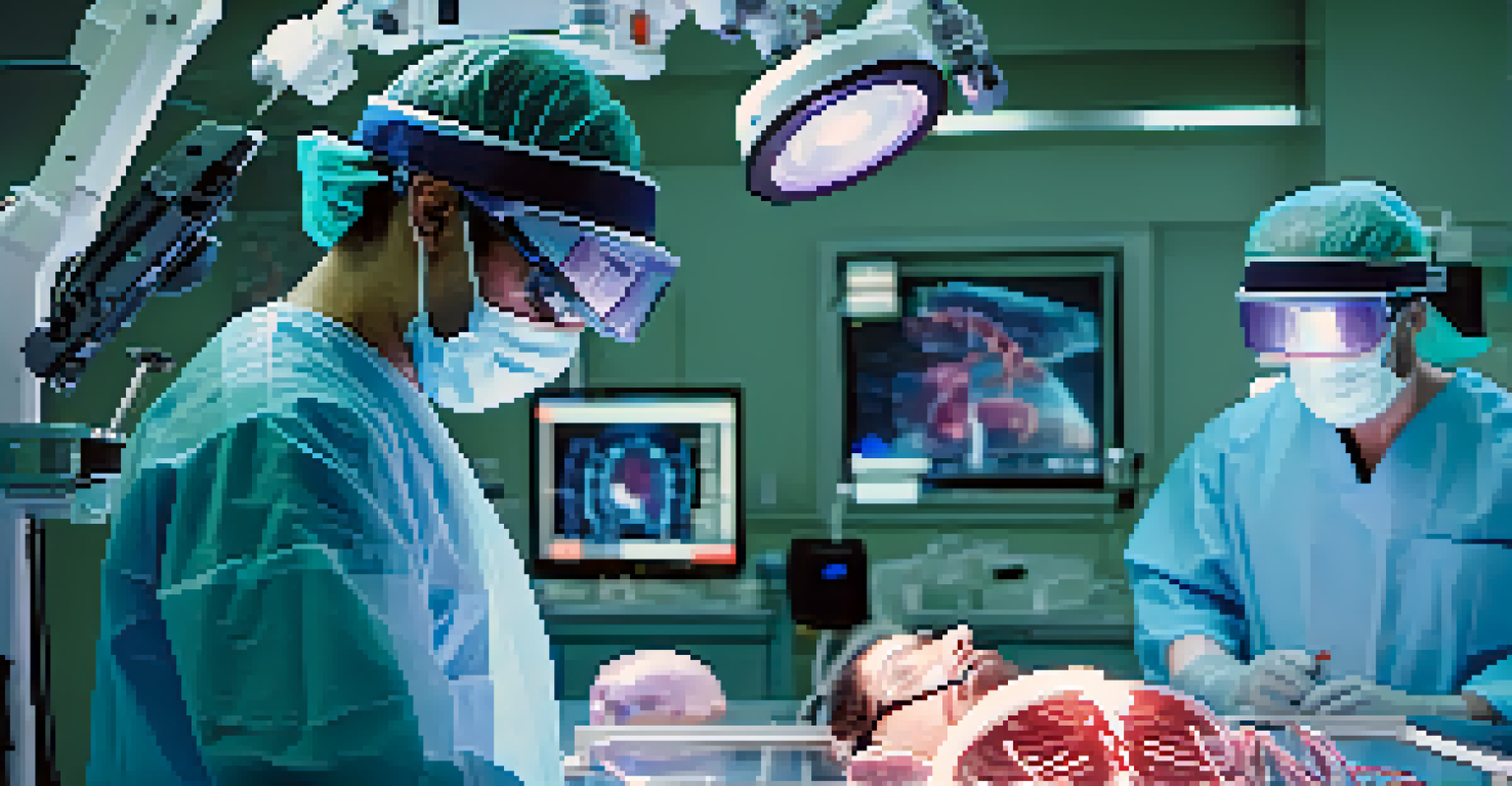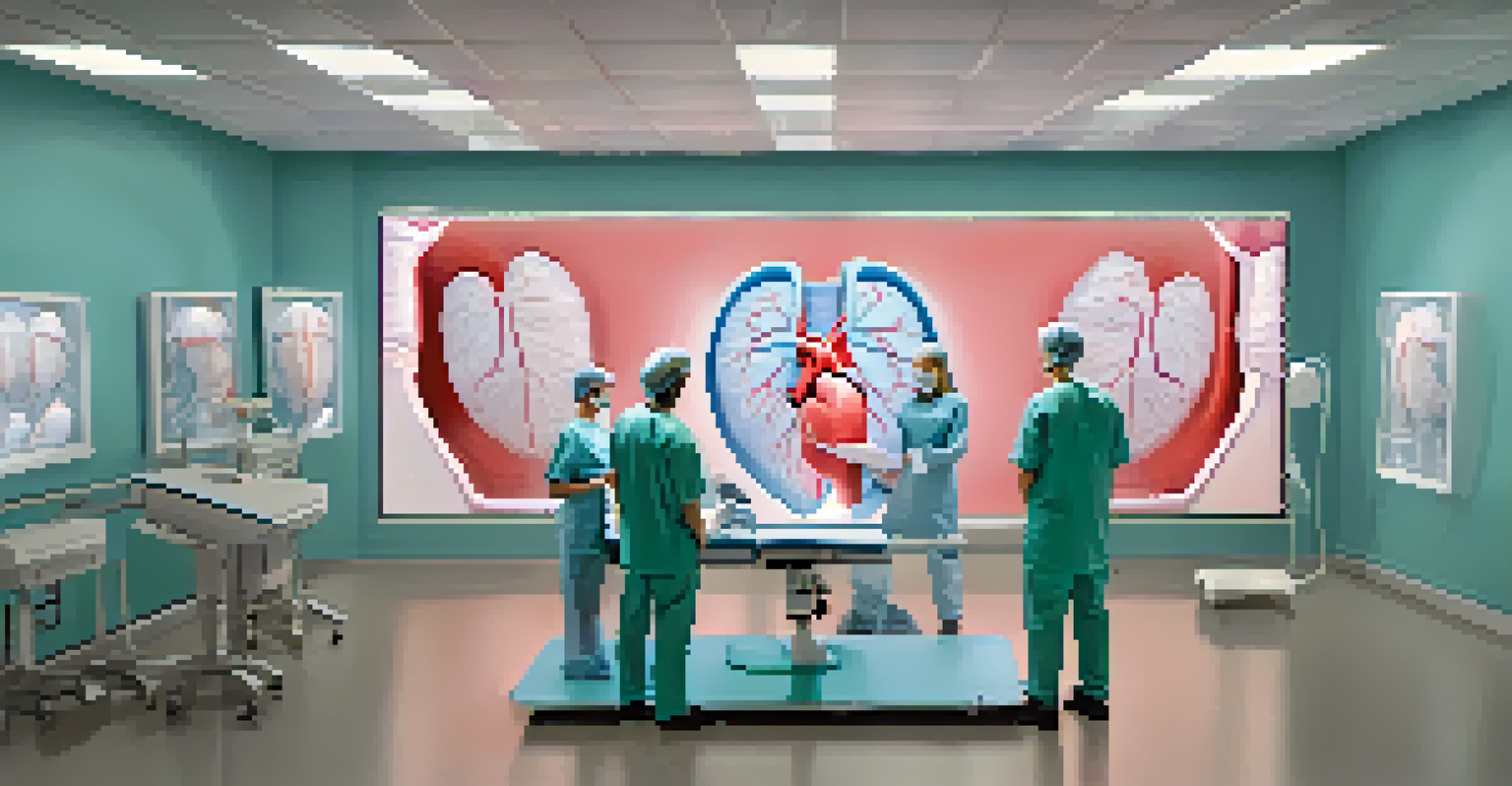Augmented Reality in Surgery: Enhancing Precision and Safety

What is Augmented Reality in Surgery?
Augmented reality (AR) in surgery refers to the integration of digital information with the real-world surgical environment. Imagine wearing special glasses that overlay critical data, like a patient's anatomy, directly onto the surgical field. This technology allows surgeons to visualize structures that might otherwise be hidden, enhancing their understanding of the area they are operating on. By providing a clearer picture, AR enables more informed decision-making during procedures, ultimately benefiting patient outcomes.
Augmented reality is the bridge between the digital and physical worlds, enhancing our perception and interaction with reality.
The concept of AR isn't new, but its application in surgery is relatively recent. Surgeons have long relied on 2D images like scans and X-rays, but AR takes this a step further by creating a 3D representation of the anatomy. This immersive experience can significantly reduce the time spent on complex procedures, as surgeons can navigate the surgical site with greater ease and accuracy. It's like having a GPS for the human body, guiding the surgeon through intricate pathways.
In essence, AR bridges the gap between digital information and physical reality, making it a powerful tool in the operating room. As technology continues to advance, the potential for AR to revolutionize surgical practices only grows. Surgeons equipped with AR tools can perform with enhanced precision, leading to safer surgeries and quicker recovery times for patients.
Benefits of Augmented Reality in Surgical Procedures
One of the most significant benefits of AR in surgery is its ability to improve accuracy. When surgeons can see a 3D model of a patient's anatomy overlaid on their body, they can plan their approach more effectively. This level of detail helps them avoid critical structures, such as nerves and blood vessels, which can minimize complications during surgery. It's like having a detailed map that shows all the hidden hazards along the route.

Moreover, AR can enhance the training of new surgeons. By using simulations that incorporate AR, trainees can practice procedures in a risk-free environment. They can visualize the surgery as if they were performing it on a real patient, which helps build their confidence and skills before stepping into the operating room. This hands-on experience can lead to better-prepared surgeons who can deliver higher-quality care.
Additionally, AR can facilitate collaboration among surgical teams. With shared visualizations, team members can discuss strategies and approaches in real-time, even if they are separated by distance. This connectivity fosters a sense of teamwork and ensures everyone is on the same page, ultimately leading to improved patient safety and outcomes.
Challenges in Implementing Augmented Reality in Surgery
Despite its advantages, the integration of AR in surgery faces several challenges. One major hurdle is the cost of the technology, which can be prohibitive for many hospitals, especially smaller ones. Investing in AR equipment and training can strain budgets, leading some facilities to hesitate in adopting this innovative approach. It's a classic case of weighing the upfront investment against long-term benefits.
The future of surgery is not just about the scalpel, but about the tools we use to visualize and understand the human body.
Another challenge is the need for compatibility with existing surgical tools and systems. Surgeons are accustomed to their instruments, and introducing new technology requires a learning curve. Ensuring that AR systems can seamlessly integrate into the workflow without causing disruptions is crucial for widespread acceptance. After all, the operating room is a fast-paced environment where every second counts.
Lastly, there are concerns about the reliability of the technology during surgeries. Any malfunction could potentially jeopardize patient safety. As AR continues to evolve, developing robust systems that can withstand the rigors of the operating room is essential. Surgeons need to trust that the technology will perform consistently when it matters most.
Case Studies: Successful Use of AR in Surgery
Several hospitals have begun to integrate AR into their surgical practices with impressive results. For example, a prominent medical center in Europe used AR to assist in complex spinal surgeries. By overlaying 3D images of the spine, surgeons could precisely place screws and rods, significantly reducing the risk of complications. This real-world success story highlights how AR can enhance surgical precision and patient safety.
Another notable case involved a team of surgeons performing a liver transplant. By utilizing AR, they were able to visualize the intricate vascular structures of the liver in real-time, allowing for a more strategic approach during the operation. This careful planning led to a reduced surgery time and improved recovery for the patient. Such examples showcase the transformative potential of AR in the surgical landscape.
These case studies not only demonstrate the effectiveness of AR but also inspire other medical facilities to explore its possibilities. As more success stories emerge, the medical community may be encouraged to invest in this technology, paving the way for widespread adoption. The positive outcomes from these procedures illustrate that AR is not just a futuristic concept; it's a practical tool reshaping the way surgery is performed.
Future Trends in Augmented Reality for Surgery
Looking ahead, the future of AR in surgery holds immense promise. As technology continues to advance, we can expect even more sophisticated AR systems that provide real-time data analysis during procedures. Imagine a system that not only overlays images but also offers predictive analytics, helping surgeons anticipate potential complications before they arise. This level of insight could revolutionize surgical practices and patient care.
Furthermore, the integration of artificial intelligence (AI) with AR could lead to personalized surgical experiences. By analyzing a patient's unique anatomy, AI could assist in creating tailored surgical plans that enhance outcomes. This synergy between AR and AI could transform surgery from a one-size-fits-all approach to a highly customized and precise practice.
Lastly, as AR technology becomes more accessible and affordable, we can anticipate its widespread adoption across various surgical specialties. From orthopedics to neurosurgery, the potential applications are vast. The continued evolution of AR will not only improve surgical precision but also enhance patient safety and satisfaction, marking a new era in healthcare.
The Role of Training and Education in AR Surgery
Training and education play a pivotal role in the successful implementation of AR in surgery. Surgeons must be adept at using AR tools to fully leverage their capabilities during procedures. This requires dedicated training programs that focus on both technical skills and the integration of AR into surgical workflows. Institutions that prioritize this education will be better positioned to harness the benefits of AR technology.
Simulation-based training that incorporates AR can provide surgeons with invaluable experience. By practicing in a controlled environment, they can familiarize themselves with AR systems and learn how to respond in real surgical scenarios. This hands-on approach can build confidence and proficiency, ensuring that surgeons are well-prepared when they encounter AR in the operating room.
Additionally, continuous education will be essential as AR technology evolves. Surgeons will need to stay updated on the latest advancements and best practices to maximize the effectiveness of AR in their procedures. A commitment to lifelong learning will ensure that surgical teams can adapt to new technologies and maintain high standards of patient care.
Conclusion: The Promise of Augmented Reality in Surgery
In conclusion, augmented reality is poised to significantly enhance the landscape of surgery. By providing surgeons with real-time, 3D visualizations, AR improves precision and safety, ultimately leading to better patient outcomes. As we've explored, the benefits of AR extend beyond individual procedures, impacting training, collaboration, and the overall efficiency of surgical teams.
While challenges remain in the adoption of AR technology, the successful case studies and future trends signal a positive trajectory. With continued investment in training and infrastructure, we can expect AR to become a standard tool in surgical practice. The potential for personalized, data-driven approaches will further empower surgeons to deliver exceptional care.

As we look to the future, the integration of augmented reality in surgery represents a transformative shift in how we approach medical procedures. By embracing this technology, we can enhance both the surgeon's experience and the patient's journey, making surgery safer and more effective than ever before.